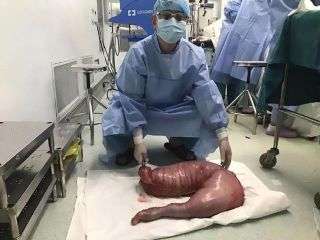
The section of colon that was removed was 30 inches long and weighed nearly 29 lbs.
When doctors in China removed 30 inches of a young man’s colon, they also removed nearly 29 lbs. (13 kilograms) of his feces.
The 22-year-old’s belly had swelled past the size that would be seen in a pregnant woman, at full-term, according to a Chinese news agency that reported his case. He told doctors that he had been constipated since birth, and that laxatives provided only slight relief.
The man had a very rare condition called Hirschsprung’s disease, the website Inverse reported.
Hirschsprung’s disease is a birth defect that affects about 1 in 5,000 babies in the U.S., according to the National Institute of Diabetes and Digestive and Kidney Diseases (NIDDKD). People with the condition have no nerve cells within the wall of their colon, toward the end of its length. The condition is more common in boys than in girls, and is also more common in children with other medical problems, including congenital heart defects and Down syndrome. [Get Gutsy About Your Digestive Health]
Normally, these nerve cells signal to the muscles of the bowel to alternatively contract and relax, to move stool along through the colon to the rectum. Without nerve cells, the bowel cannot effectively move stool through it, which can lead to severe constipation, according to the NIDDKD.
Nerve cells within the bowel wall form early in a fetus’s development, the NIDDKD says. These cells first form at the top of the bowel and grow toward the opposite end. In those with Hirschsprung’s disease, the nerves do not reach the end of the bowel. The condition can range in severity, depending on how far along the colon the nerve cells grew before they stopped. For example, in some cases, nerves are missing only from the very end of the large intestine, but in other cases, they can be missing from the entire large intestine and even parts of the small intestine.
The most obvious sign that a newborn has Hirschsprung’s disease is that the baby does not have a bowel movement within the first 48 hours after birth, the Mayo Clinic says. Other symptoms can include a swollen belly, vomiting a green or brown substance, constipation, gas or diarrhea.
But in some cases, the condition isn’t apparent until later in life. In older children, the symptoms can include a swollen belly, constipation, gas and fatigue, according to the Mayo Clinic. [5 Things Your Poop Says About Your Health]
Of course, many infants and children can develop constipation for other reasons. A key difference is that in infants or children with Hirschsprung’s disease, constipation drugs taken by mouth, such as laxatives, typically do not have an effect, the NIDDKD says.
The only treatment for Hirschsprung’s disease is surgery to remove the defective part of the colon, according to the NIDDKD.
Rarely, Hirschsprung’s disease remains undiagnosed until a person reaches adulthood. In a 2006 report in the journal Annals of Diagnostic Pathology, researchers estimated that about 300 cases of adults or adolescents diagnosed with the condition have been described in the medical literature.
The disease is difficult to diagnose in adults, according to the case report. A number of other conditions can cause a large build-up of poop in the colon in adults, including problems with the movements of the colon, blockages and twists in the intestine called volvulus. A biopsy showing that the colon lacks nerve cells is needed to diagnose the condition.
Originally published on Live Science.
Sourse: www.livescience.com





